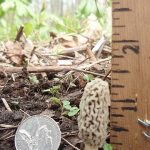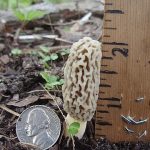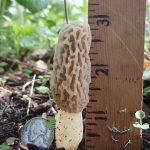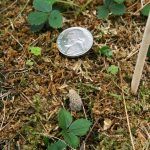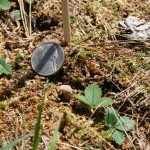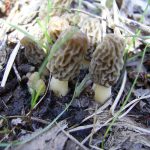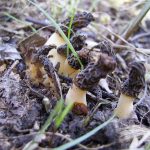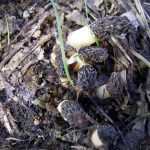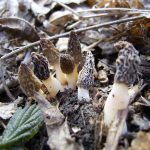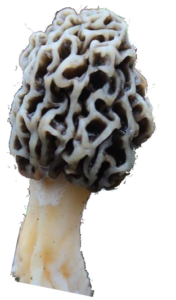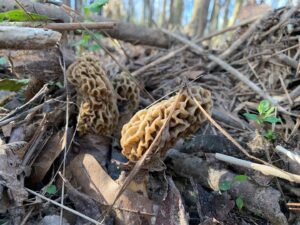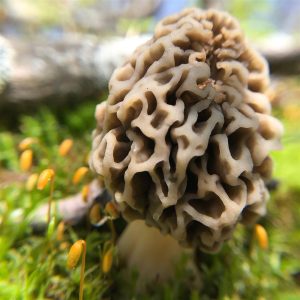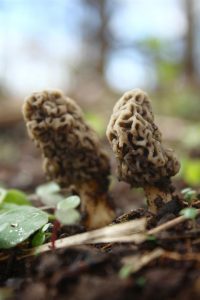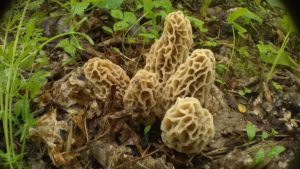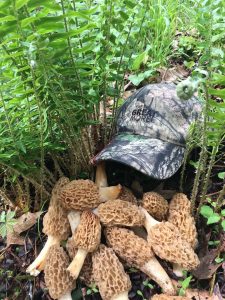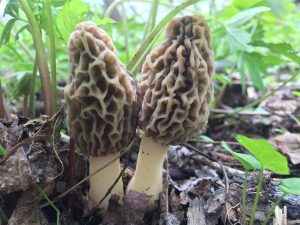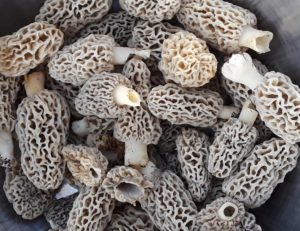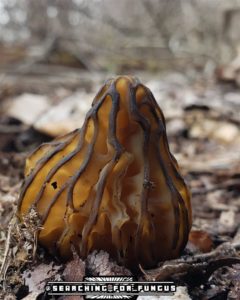The Great Morel has been honored to share three separate studies of the morel growth cycle. Each study includes time-lapse photo and other substantial data for detail as to weather and ground conditions. It is interesting watching the morel growth cycle and the studies certainly answer some of the questions many morel hunters have wondered. A special thank you to all who have contributed and The Great Morel will add additional studies when they become available.
These three images show a nice little time-line of the morel
- Day One (1)
- Day Three (3)
- Day Six (6)
“My husband has been in the woods every day since the mushrooms started.
He has been marking and taking pictures every couple days. This picture shows
the growth over a period of 6 days.” – Courtesy of Diana Wolfe in north central Indiana
Another day-by-day photo gallery of Patch # 2 courtesy of David Guillemette
- May 8 Day 1
- May 9 Day 2
A 2009 Study of the Birth Place of the Morel
The Great Morel is pleased to present this 2009 study of the growth of the West Virginia morel. Clint Ely, who is a well renowned morel hunter located in West Virginia has so kindly agreed to share his personal study of the growth cycle with visitors of The Great Morel. Clint’s data is somewhat different then the 2008 study by David Guillemette . Clint has decided to initially log data specific to the soil. The scope of Clint’s study is to attempt to document PH content and soil temperature of various morel patches.
Clint has so graciously provided this data and will soon be supplying photos. As you can understand, Clint has left out the GPS coordinates as not disclose his prize morels.
| The Great Morel Hunt of 2009 by Clinton Ely | ||||||
| SITE A | Location: | Somewhere in West Virginia | ||||
| Species | PH | Soil Temp | Date | Notes | ||
| 1 | Yellow | 6.7 | N/A | 4/16/2009 | 1″, cap above ground, stalk not visible | |
| 2 | Yellow | 6.5 | N/A | 4/16/2009 | Large cap, stalk not grown yet | |
| 3 | Yellow | 4/19/2009 | Is number 1 morel, grown 1/4″ | |||
| 4 | 4/19/2009 | Number 2 morel, not growing yet | ||||
| 5 | ||||||
| 6 | ||||||
| SITE B | Location: | Somewhere Else in West Virginia | ||||
| Species | PH | Soil Temp | Date | Notes | ||
| 1 | Black | 6.9 | N/A | 4/18/2009 | Near Tulip Popular Trees, S facing, 2″ | |
| 2 | Black | 6.9 | N/A | 4/18/2009 | All 1-3 found in same area, rocky soil | |
| 3 | Black | 6.9 | N/A | 4/18/2009 | ||
| 4 | Black | 6.9 | 55.6 | 4/20/2009 | 3″, near dead cherry branch | |
| 5 | Grey | 7.0 | 55.3 | 4/20/2009 | 2″ baby, small cap, found 2′ from blacks | |
| 6 | Blonde | 6.7 | 56.5 | 4/20/2009 | 2″, found near blacks, area with 3 others | |
| 7 | Blonde | 6.9 | 56 | 4/20/2009 | 2″, found with 6 | |
| 8 | Black | 6.8 | 56.2 | 4/20/2009 | 3″, found in leaf litter | |
Journal of Clint’s E-mail Notes
- On Thu, 4/16/09, Clint wrote: Good afternoon! I went out shroom hunting today in another area and only found 2 barely sprouting yellow morels… no stalk yet just half of the head poking out of the ground. I collected the PH of the soil and some other information. I will buy a thermometer tomorrow and will be hunting this weekend. Some good info I have found is to load the GPS coordinates in Google Earth and check out the area with the sliding time/sun option! It is neat as hell, so far I have found that the areas getting the most sun is the spot currently to look at. I will report back to you this weekend with the information. Tools I am using: Garmin GPS navigator Walmart PH/Fertilizer tester Digital Thermometer Digital Camera As soon as I get more data, I will attempt to make an easy table for the info. Until then, take care! –Clint
- On Thu, 4/21/09, Clint wrote: Hello Great Morel, I am attaching a rougly made Excel sheet. I will include more information, I just wanted you to know that I am working on this for you. A bit of a slow period for a week then you and I will both be eating shrooms! I’ll give you the GPS coordinates for your own study that way I won’t have 1000 lazy people taking over my spot. An interesting note… the black morels grow at the 55F while the blondes seem to prefer the warmer 56F at least. I hope I can find out more when this is all said and done. I’ll upload some pics when I can. –Clint
Click here to see Dave’s growing study which has more detail
This 2007 study below was contributed by Scott Keller from western Illinois. This study contains what was to be a series of photos showing the life cycle of a morel patch. Unfortunatley Mother Nature threw a blanket of cold upon the midwest in the spring of 2007. So what was to be a study of life, turned out to be a study of the death of a morel patch. The Great Morel had asked Scott if he would photograph his patch and chronologically keep data. As you will see it turned into a study of a different kind.
Here is Scott’s storyline:
Here is our first little cluster that my friend and I stumbled upon, the largest morel was the size of a quarter, I didn’t think to put one down for the picture, but if you zoom in at the babies you can see one is so new and small it does not even have a cap on it yet! I took this photo today (4/5/2007) near the Mississippi river in Missouri.
…unfortunately mother nature felt it necessary to unleash a crazy cold snap and high winds. I took a photo of the same cluster at almost exactly the same angle plus a top view even though they were dying, also I had to clear a leafy view that was obstructing the shot. I thought you may find this interesting of what a sudden cold snap did to this and many other clusters out here. Our temperatures were: 4/5/07 (high 42, low 26), 4/6/07 (high 32, low 25) and today 4/7/07 (high 46, low 26). Please note that on 4/3/07 our temperatures were at a high 70 and had dropped 32 degrees the next day.
Although…on the other side of the tree we find growth that has survived healthy from 2 days ago with new growth which must have come up during yesterdays high of 32 (4/7/07). – see the last photo in the gallery.
- First cluster
- Cold snap setting in
- cold weather taking its toll
Related links and information:
- Growth Cycle
- False Morels
- Decaying Morel Images
- Preserving your Morels
- FAQ – Life Cycle
- The Life of The Great Morel

